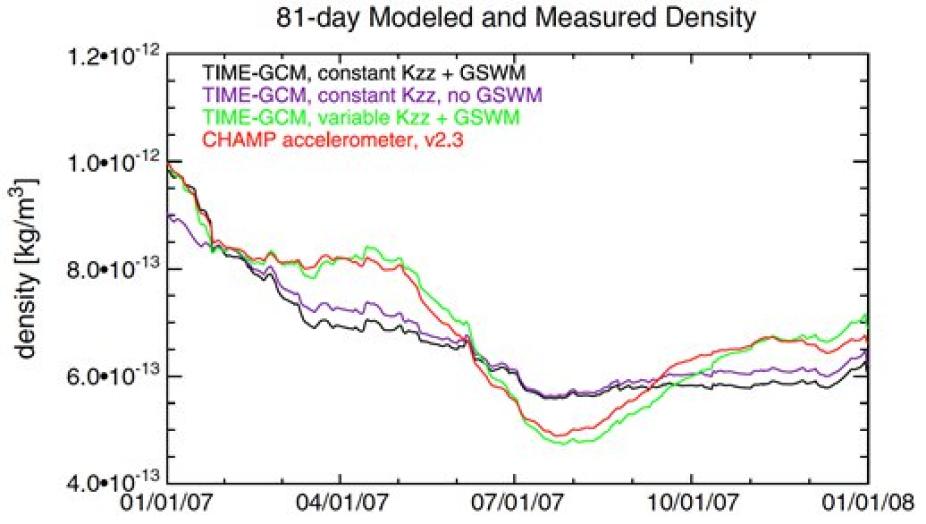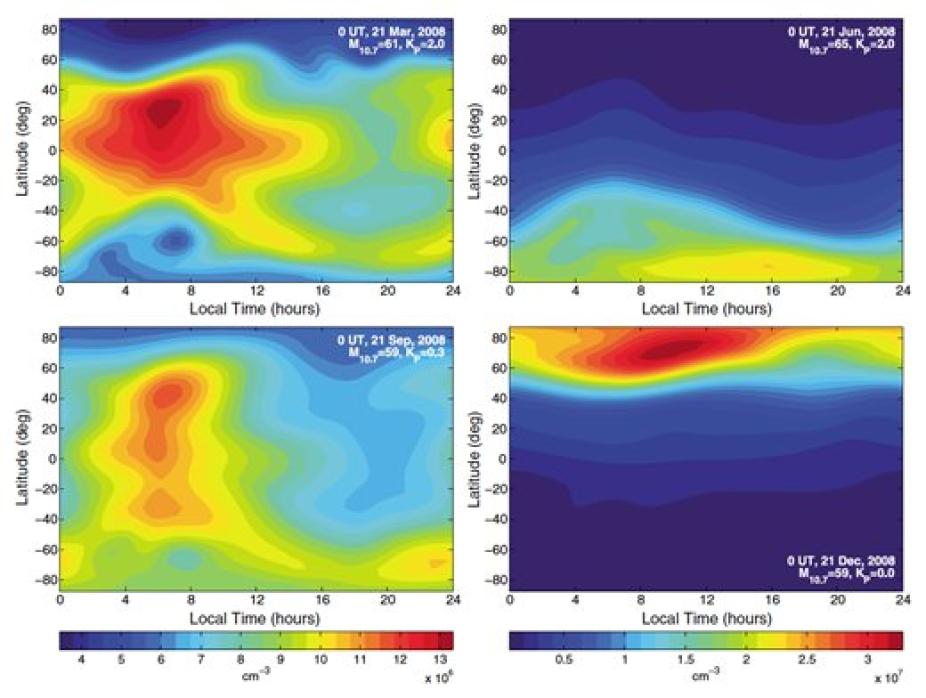Satellite Drag Physical Modeling for Transition to Operations
The ionosphere and upper atmosphere play a major role in space operations, including communications, navigation, and satellite drag. Satellite drag, the drag force exerted by the tenuous upper atmosphere on orbiting bodies, is the leading cause of error in predicting the locations of objects in low-Earth orbit. As the population of satellites and space debris grows with time, higher orbital prediction accuracy is required for tracking, collision avoidance, reentry prediction, and satellite lifetime calculations. Satellite drag is constantly changing because thermospheric density is highly variable with geographic location and time, due to atmospheric dynamics and waves, solar ultraviolet flux changes, and geomagnetic disturbances, i.e., space weather.

Neutral densities at 400 km during 2007 modeled by the TIME-GCM using a constant eddy diffusion and tides from the Global Scale Wave Model (GSWM) (black), constant eddy diffusion without tides (purple), variable eddy diffusion with GSWM tides (green), and CHAMP accelerometer density measurements (red).
The goal of the Atmospheric Density Assimilation Model (ADAM) development is to accurately predict current and future satellite drag with a suite of thermosphere-ionosphere “full physics” models, using real-time space weather data. This Small Business Technology Transfer (STTR) project for the US Air Force is led by a small business, Atmospheric & Space Technology Research Associates (ASTRA), and has participation from the NCAR High Altitude Observatory, the University of Colorado, and the NOAA Space Weather Prediction Center (SWPC). Recent work by this group has resulted in significant progress understanding the seasonal variation in thermospheric density by Pilinski and Crowley [2015] using the NCAR Thermosphere-Ionosphere-Mesosphere-Electrodynamics General Circulation Model (TIME-GCM), following on from the work of Qian and Solomon at HAO [Qian et al., 2009]. The figure below shows a comparison of TIME-GCM density predictions, using various lower boundary conditions, with measurements from the CHAMP satellite.

Global distribution of helium number densities at 250 km altitude during each season for solar minimum conditions (2008), as calculated by TIE-GCM. (left) Equinox plots share a common color scale, as do (right) solstice plots.
Other advances related to the satellite drag problem include the addition of helium to the Thermosphere-Ionosphere-Electrodynamics General Circulation Model (TIE-GCM). At very high altitude (~500 km) it is not enough to calculate the major constituents of the upper atmosphere (molecular nitrogen and atomic oxygen), because helium becomes a significant fraction of the density. Due to its small molecular mass, it diffuses to the top of the atmosphere and tends to collect over the winter polar region. This was successfully simulated by Sutton et al. [2015], working with researchers and programmers at HAO, is now a standard part of both the TIE-GCM and TIME-GCM, and is being added to the WACCM-X model.
Pilinski, M. D., and G. Crowley (2015), Seasonal variability in global eddy diffusion and the effect on neutral density, J. Geophys. Res. Space Physics, 120, 3097, doi:10.1002/2015JA021084.
Sutton, E. K., J. P. Thayer, W. Wang, S. C. Solomon, X. Liu, and B. T. Foster (2015), A self-consistent model of helium in the thermosphere, J. Geophys. Res. Space Physics, 120, 6884, doi:10.1002/2015JA021223.